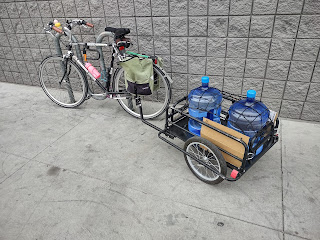The Toolbox vs. The Swiss-Army Knife
One thing that I think is often overlooked in discussions around urban mobility and alternative transportation is that the car is a truly versatile transportation tool. If you have a well-maintained car in your garage, you can decide, on a moment's notice, to travel any distance, from around the block to across the country, and you can generally expect to find maintained high-speed roads going direct from where you are to where you want to be. The car is a Swiss Army knife of transportation, a tool for any purpose. If you have one, you probably don't even think about using anything else to get around, and this results in a common response to proposals to diminish cars' presence in our lives-- "You can't seriously expect everyone to ride a bike/take the bus/walk/etc. everywhere."
And you're right! I can't! There are a lot of reasons why a particular mode might be unsuitable for a particular trip. In Las Vegas, for example, summer heat can often be intolerable for people trying to walk or cycle. Do I expect people to ride bikes everywhere at high noon in August? No, that's absurd! But those who might otherwise walk or cycle can opt to use transit instead at those times-- RTC's air conditioning is often too cold!
The point to understand, and something to get used to if you're one of the many Americans turning to transit and active transport during this time of high gas prices, is that there probably isn't a single thing that can replace your car. You aren't going to swap your car keys for bike keys and never again think about your transportation choices; ditto a bus pass. What can replace your car is an entire system of alternative mobility, each piece of it filling its own role.
As a car-free Las Vegan myself, I use a wide variety of tools to move myself around and outside of the Valley, so let's take a look at those tools and see what role each of them plays in a well-lived, car-free life:
- Bicycle- My venerable 2010 Fuji Cambridge, a quasi-Dutch city bike, along with the trailer that I use for errands. (I don't recommend the model anymore; it was re-designed in recent years to be a cheap beach cruiser.) I use my bike for most trips within about five miles of home, and sometimes for longer trips when the weather's nice, and I use the trailer to haul groceries and most of my other shopping home. A decent bicycle will run you around $500-$700 new and will last for a decade or longer; this one is 12 years old. The cost of operation is basically zero.
- Bus- RTC Transit, the main transit provider in Las Vegas, carries me on most journeys further afield. For extra versatility, transit buses here all carry 3-position bicycle racks, and the combination of cycling and public transit makes many journeys out in the outer suburbs more possible than otherwise. This is the combination that gets me to Floyd Lamb Park, for example.
- Bikeshare- A system of public rental bicycles that operates in and around downtown Las Vegas, I've found RTC Bikeshare to be convenient for connecting between east/west transit routes and the downtown area. I often use it when going downtown when I can't leave my bicycle behind somewhere, such as when I'm connecting to Flixbus.
- Monorail- It's the last of the local transit options on this page, and that is for a reason-- it's not even always that useful for tourists, and it's rarely useful for locals. But the price is right! Locals with a Nevada ID can buy tickets for just $1 (when staffed ticket booths are open), or 20-ride tickets for $20. I carry a couple in my wallet for the odd occasion when it's useful to me, mostly when traveling to the southeast corner of the city... but not too southeast, like not as far south as the airport...
Anyway, if you want to use it as an actual local transit option, you should know that there is street access at the Sahara station via escalator and elevator, and also a sometimes-functional elevator at the Flamingo-Caesar's Palace station. - Intercity Bus- Unfortunately, Las Vegas is the largest city in America with no rail service at all, so if you're heading out of town, you're probably going to be going by bus. Fortunately, though, we are served by a pretty extensive network of bus routes, both on the Flixbus and Greyhound systems. From Las Vegas, you can get to LA, Reno, San Francisco, Phoenix, Albuquerque, Salt Lake, Denver, and even one daily trip all the way to New York City! There are also bus services that will connect you to Amtrak's Southwest Chief at Kingman
- Airline- It's not the most climate-friendly form of transportation, but you don't need a car to fly out of Reid Airport, to destinations throughout the country, sometimes in surprisingly out-of-the-way places! (The EAS program should probably be replaced with rail and bus in many places, but that doesn't mean you can't use it!)






.jpeg)
Comments
Post a Comment